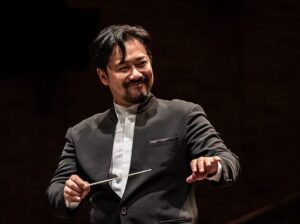China Shenzhen Symphony Orchestra
Daye Lin (conductor), Jiaoneg Nie (cello), Tamsin Waley Cohen (Violin)
Fairfield Halls, Croydon 22 March 2024
Tan Dun has a long association with China Shenzhen Symphony Orchestra which was established in 1982. He is currently principal honorary conductor so it made sense to start this concert with what is probably his best known work. The highly atmospheric, vibrant theme music for the 2000 film Crouching Tiger, Hidden Dragon has been reworked by the composer as a three movement piece – effectively a cello concerto.
Jiapeng Nie is a passionate cellist who really leans on the glissandi. High spots included a fabulous percussion interlude in which the cello eventually joins – almost inaudibly. I also liked the delivery of the melody-rich, lyrical middle movement with all five percussionists playing different sorts of drums with bare hands and outstretched fingers, as if playing pianos. The passage in which string players play percussive pizzicato, stopping the sound with a tap of the hand came off effectively too.
Then came the arrival of most of the woodwind section (only flutes in the Tan Dun piece), the brass section and the departure of four fifths of the percussion because Poème by Ernest Chausson (1896) needs only timps. Tamsin Waley-Cohen is an accomplished soloist whose double stopping and poise is a masterclass in how to do it. It’s a difficult piece which requires a great deal of sensitive control which it got in this performance from both Waley-Cohen and conductor Daye Lin who packed it with high levels of both elegance and eloquence. Then, as her encore, Waley Cohen treated us to Recitativo and Scherzo-Caprice by Fritz Kreisler: a showpiece which allowed us to enjoy more of that excellent double stopping.
But the real meat in this concert came after the interval in a glitteringly arresting performance of Mahler’s Symphony Number 1 (1889). The requisite huge forces assembled (including eight horns, three bassoons and a contra, double brass and so on), it was compelling almost from the first note with three off-stage trumpets in duet with the horn and I’m not quite sure how you make that first subject melody sound as mysterious as Chinese film music but that’s what Daye Lin does – his right hand more or less beating time while he signals with his extraordinarily expressive left hand, every finger conveying a message.

The second movement – based on an Austrian Landler – was very exciting with terrific oboe work and as for those sumptuous slides in the “trio”, players were clearly relishing them as much as I was. The third movement, which famously riffs on Frere Jacques in a minor key as a funeral march, is always glorious and this performance more than did it justice with some unusually colourful tempo changes. Moreover, this was the first time I had ever noticed the Klezmer sound in the accelerating sexy brass section but it makes perfect sense. Although he later converted (expediently?) to Catholicism, Mahler’s parents were both Jewish.
The rousing finale packed lots of drama and dynamic contrasts and it was a nice touch to bring the eight horns to their feet for their big moment just before the end. I suspect it will be long time before I hear this symphony played with such joyous energy. Mahler has to be played with feeling or it doesn’t work – and this certainly was. And if it was a bit exaggerated in places then it just added to the excitement.
It’s a pity, therefore, that this concert was so sparsely attended. Many people missed what turned out to be quite an experience, especially in the second half.